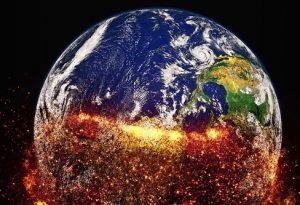A Fight Against the Fossil Fuel Industry
It took Bill McKibben, a world renowned environmentalist and journalist, around a decade after writing his first book on climate change to realize that he had mis-analyzed the issue.
The theory was that McKibben, along with the rest of the scientific community, were engaged in an argument with the fossil fuel industry regarding whether or not climate change was real. They thought that if they kept arguing, eventually the politicians and leaders of the country would realize that they were ignoring the greatest threat to the planet.
But they weren’t in an argument, they had won that long ago. By the mid-1990s, the scientific community was in a strong consensus of what the problem was, they had already proved that climate change was occurring. “We weren’t really in an argument, we were in a fight,” McKibben said, at a talk given at the University of Michigan in October. “And the fight was [against] the fossil fuel industry – the richest force on the planet. And [they] were able to use that money and power to prevail in that fight, despite having lost that argument.”
But, the fossil fuel industry already knew what they were doing to the planet. Exxon, an oil company in the U.S., employed the country’s best scientists to research climate change. By the late 1970s and early 1980s, they knew exactly what was going to happen to the planet if they continued on their trajectory. The scientists were spot on, and the company believed them.
Exxon began building higher oil rigs to compensate for the rising sea levels that they knew were coming. “But, what they didn’t do was tell the rest of us, what they did instead was invest millions of dollars in deceit and disinformation that has kept the completely pointless debate about whether or not global warming was real alive,” McKibben said. Both sides, science and the fossil fuel industry, both knew what the answer was — they both knew that climate change was real, but the fossil fuel industry refused to admit it. That is partly the reason why the world is in the situation that it is in now.
“One has to talk frankly about the scale and the pace of the problem that we face, when asked to be realistic about where we are,” McKibben said. “And where we are, we’re going to walk in the valley of the shadows for a minute here because it’s not good.”
Humans have increased the planet’s temperature by 1.8 degrees Fahrenheit. This doesn’t sound like much, but it turns out that it is a big stress factor in the extra heat that has been trapped in the atmosphere due to the excess carbon being produced by burning coal, oil, and gas.
According to McKibben, the extra heat being produced is the equivalent of 400,000 Hiroshima sized bombs a day. “We know it’s that heat because of what it’s done,” McKibben said. “Look up at the Arctic, we’ve lost half of the summer sea ice there, think about the heat required to do that — to melt a continent-size chunk of meters-thick-millennial-old ice. Think about the ocean, after all, we’re an ocean planet. The extra carbon we put in the atmosphere is absorbed by the [ocean], and when this is absorbed, it changes the chemistry.”
The oceans are now 30% more acidic than they were 40 years ago. This is a staggering change — a change that is causing unbelievable damage to the planet. The Great Barrier Reef, the largest living structure on the planet, is now only half as big as it was 18 months ago.
And the increased heat has also done it’s damage. “Warm air holds more water vapour than cold air, if you want one fact to understand in the 21st century, that’s the one to pick,” McKibben said. “It means in arid areas, we get much more evaporation than we’re used to, and hence more drought. There’s a lot of death on the globe now, we see those droughts kick in with the most devastating effects.”
The worst drought in history has occurred in what was once called the Fertile Crescent. Spanning across the Middle East, the effects of this drought have been huge. “It seems to be one of the triggers for the civil war in Syria that now is sending refugees screaming across the planet,” McKibben said.
All around the world, areas are experiencing droughts, causing forest fires that are more intense than ever before. And all this water that has been evaporated into the atmosphere is let out in the form of rain on other parts of the world. “Rainfall on a scale that was once impossible to imagine, except on a world where we’ve begun to change. When Hurricane Harvey came to Houston, it obliterated the U.S. record of largest rainfall ever [with] 54 inches of rain,” McKibben said. And those records were challenged when just 10 days later when Hurricane Maria hit Puerto Rico, leaving the entire island without power and causing unbelievable damage.
In addition, other parts of the world have gotten too hot to simply live. In the last year, Ahvaz — a city in Iran with a population of 1.1 million people — reported the highest ever reliably recorded temperature of 129 degrees Fahrenheit. “That’s too hot to work, to hot to sleep in, basically too hot to live for any real period of time,” Mckibben said. “That is the reality of the world in which we currently live.”
And that is only some of the effects of the changing climate.
“The world made its first real small effort to do something about this in Paris two years ago,” McKibben said. “[But] even if we followed every single promise that everybody made in Paris, we would still be on a trajectory to increased temperatures by 7 degrees Fahrenheit. And that would be enough to not just cause problems, but to threaten the civilizations that we know today. We are up against the biggest problem that we have ever faced. We have to do something about it now.”
But there is good news. The scientific community knows what needs to be done. Around 10 to 15 years ago, McKibben recalls that all they knew was that the world had to get off of fossil fuels. Although the world is inevitably heading towards rising temperatures, the answer to softening these effects lies in renewable energy.
In the last ten years, McKibben credits engineers to doing the most to make renewable energy affordable. Last year Denmark’s generated half the power it used with wind, using the same resources available to the United States but put to good use.
Last year, while McKibben was in East Africa for the New Yorker, he got watch places that never had power before skip the fossil fuel age and go straight to renewable energy, getting electricity from solar panels on the roofs of their huts. “It was incredibly moving to watch, incredibly moving to see people have their first glass of cold water,” McKibben said.
Although the scientific community is in consensus of the problem and solutions to it, the fossil fuel industry has slowed the progress of saving the planet. But still, with rising awareness and huge steps being made in renewable energy, there is hope for the future. “Green power is now the cheapest way to produce [electricity] all over the world,” Mckibben said. “We can do this, I know we can do it.”










